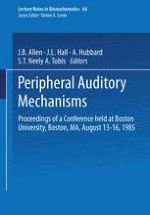1986 | OriginalPaper | Buchkapitel
On the Role of Fluid Inertia and Viscosity in Stereociliary Tuft Motion: Analysis of Isolated Bodies of Regular Geometry
verfasst von : Dennis M. Freeman, Thomas F. Weiss
Erschienen in: Peripheral Auditory Mechanisms
Verlag: Springer Berlin Heidelberg
Enthalten in: Professional Book Archive
Aktivieren Sie unsere intelligente Suche, um passende Fachinhalte oder Patente zu finden.
Wählen Sie Textabschnitte aus um mit Künstlicher Intelligenz passenden Patente zu finden. powered by
Markieren Sie Textabschnitte, um KI-gestützt weitere passende Inhalte zu finden. powered by
We assume that cochlear fluids are Newtonian and show that for physiological stimuli: fluid compressibility is negligible; convective non-linear inertial forces are small; and both viscous and linear inertial forces are appreciable. We examine the frequency dependence of viscous and inertial fluid forces that act on oscillating, isolated bodies of regular geometry. The mechanical admittance of such a body submerged in a fluid and supported by springs shows a geometry-dependent resonance. This resonance has a quality (Q3dB ) that is less than 1 for an infinitesimally thin plate vibrating in its plane, but can be arbitrarily large both for a sphere and for a circular cylinder oscillating in a direction perpendicular to its long axis. From considerations of hair cells with free-standing stereocilia in the alligator lizard cochlea we conclude that stereociliary tufts in the cochlea could be resonant mechanical systems.
